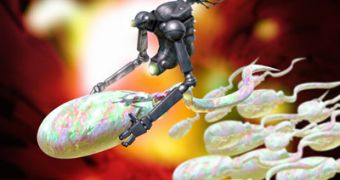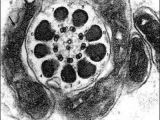The nervous swim of a sperm attempting to make you a father could soon have applications others than reproduction. Future minute nanobots could be empowered by whip-like sperm tail imitating structures, wandering around through your whole body.
Sperm would solve the issue of energy supply for nanobots, implants and "smart" probes that would carry drugs, watch enzymes and accomplish other medical tasks, as revealed by a research presented in December at the American Society for Cell Biology's annual meeting, in Washington, D.C.
The tail (called scientifically flagellum) of a human sperm moves it by 7 inches (18 cm) per hour (it is like you swimming 6 km (3.7 mi) per hour).
The energy for the sperm's movement is delivered by adenosine triphosphate (ATP), the universal energy molecule in the animals and plants, which can store, transfer and release energy. When the flagellum needs energy for a twist or bend, ATP releases it by decaying to adenosine diphosphate (ADP) or adenosine monophosphate (AMP).
ATP forms in mitochondria, organelles making cell's "power plants". Flagellum has a helix of mitochondria within the closest zone to the sperm's head. ATP is produced by the breakdown of the sugar (glucose), called glycolysis. But the last 75 % of the flagellum are free of mithocondria, as contractile proteins need space for twist or bending.
The Cornell team shows that 10 proteins involved in glycolysis in the flagellum form a solid scaffold-like support through the flagellum while still being functional. The team made two of these proteins to attach on the surface of a minute gold chip wrapped with nickel ions. The research was made on mouse sperm proteins (very similar to human ones).
After two proteins worked well in glycolysis and passing the by products to the other proteins, the researchers believe that they can do the same with the other proteins too.
The flagellum even has a transport protein working like a waste pipe to eliminate waste (carbon dioxide) for maintaining the energy producing cycle.
"Future nanodevices could include this transporter to similarly maintain their energy production." said co-author Alexander Travis, an assistant professor of reproductive biology at Cornell University's Baker Institute for Animal Health. Future nanobots could deliver capsules filled by cancer drugs or antibodies to specific cancer cells. The "sperm flagellum" technology would come with a steady ATP powering the pumps spreading the chemicals at a certain speed.
"Sperm-inspired ATP generators would need to overcome the likelihood that the altered proteins would be recognized as foreign by the body's immune system, provoking a strong immune response. Even so, some nanoparticles potentially serving as the basis for savvy devices of the future are already in use, including magnetic iron oxide particles used for advanced body imaging." said Dr. Erkki Ruoslahti, a nanotechnology researcher and distinguished professor with the La Jolla, Calif.-based Burnham Institute for Medical Research.

 14 DAY TRIAL //
14 DAY TRIAL // 
